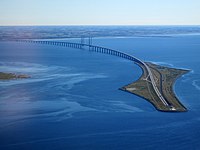
Photo from wikipedia
This paper investigates the effect of a wind barrier on the aerodynamic performance of a train–bridge system under crosswind using a numerical simulation method. The studied bridge is a long-span… Click to show full abstract
This paper investigates the effect of a wind barrier on the aerodynamic performance of a train–bridge system under crosswind using a numerical simulation method. The studied bridge is a long-span cable-stayed bridge with a flat steel box girder, located in Chongqing, China. The flow field around the train–bridge system with and without a wind barrier is numerically simulated. Wind barrier porosities varying from 10 to 60% are evaluated. The tricomponent coefficients of the train, bridge, and train–bridge system are obtained and investigated in detail. The effect of the wind barrier on the aerodynamics of the train–bridge system is revealed through the determination of the aerodynamic forces, pressure mapping, and flow visualization. The results show that a wind barrier successfully decreases the mean velocity above the girder and consequently decreases the drag force and moment on the train; however, the wind barrier also significantly increases the drag force on the girder. Therefore, installation of a wind barrier improves the running safety of the train but is detrimental to the wind resistance of the bridge. Additionally, the efficiency of the wind barrier depends on the porosity. A lower porosity improves the train safety but is more detrimental to the bridge safety. An optimal wind barrier porosity of 30% is obtained based on the aerodynamic forces of both the train and the bridge. Compared to a train–bridge system without a wind barrier, the drag force and moment on the train decrease by 66.1 and 62.9%, respectively; the drag force on the bridge girder increases to 0.86, and the drag force on the train–bridge system equals that without the wind barrier.
Journal Title: Proceedings of the Institution of Mechanical Engineers, Part F: Journal of Rail and Rapid Transit
Year Published: 2019
Link to full text (if available)
Share on Social Media: Sign Up to like & get
recommendations!